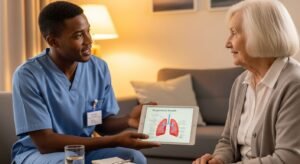Breathing is simple — until it isn’t. As we age, something we once took for granted can suddenly feel like a precious gift. This guide is written for seniors and their families who want clear, friendly, and practical information about respiratory illnesses: how they spread, how to spot trouble early, what actually works to prevent them, and how to recover without losing sleep (or patience).
Whether it’s the flu, COVID-19, RSV, or that “mystery cold” that just won’t go away, knowing the facts can make a huge difference. Here, you’ll learn not just about the science, but also the everyday habits, simple precautions, and timely treatments that can help keep your lungs happy. We’ll also talk about when it’s time to call the doctor, how to protect the people around you, and how to make a plan before illness strikes.
So grab your favorite tea, settle into your comfiest chair, and take a deep breath — we’re going to walk through everything you need to know in a way that’s easy to understand, with tips you can use right away. Keep scrolling — there’s a handy checklist at the end you can save, print, or stick to the fridge.

Table of Contents
Understanding Respiratory Illnesses
Think of your respiratory system as an intricate tree. The trunk is your windpipe (trachea), which branches out into smaller and smaller limbs (bronchi and bronchioles) deep inside your lungs, ending in tiny leaves (alveoli) where the magic of breathing happens. This entire highway, from your nose and throat all the way down, is the target for respiratory illnesses.
Most of these illnesses are caused by viruses, which are tiny invaders that need to get inside our cells to multiply. This is different from bacterial infections, which are caused by single-celled organisms that can often live and reproduce on their own. This distinction is crucial: antibiotics are designed to kill bacteria and are completely useless against viruses like the flu or COVID-19. Using them unnecessarily can lead to antibiotic resistance, a serious global health issue.
Why do we focus so much on these illnesses in seniors? Because a viral infection can be like a spark in a dry forest for someone with a chronic health condition. For example, if you have heart disease, a severe lung infection forces your heart to work much harder to pump oxygenated blood through your body. If you have diabetes, an infection can cause your blood sugar levels to spike, making it harder for your body to fight back. Beyond the physical toll, a serious illness can disrupt cherished plans, place a burden on caregivers, and impact your confidence and independence. This is why prevention and early, decisive action are your best friends.
Common Respiratory Illnesses
While hundreds of viruses can cause a sniffle, a few key players are responsible for the most serious risks. Knowing your opponent is the first step in building a strong defense.
Influenza (Flu)
The flu is a master of disguise. Caused by influenza A and B viruses, it constantly changes its outer proteins in a process called “antigenic drift.” This is why last year’s flu shot won’t protect you this year, and why an annual vaccine is essential. The flu typically hits you like a truck, with a sudden onset of high fever, deep muscle aches, and profound fatigue. For seniors, it’s a leading cause of pneumonia, a serious lung infection that can be life-threatening.
COVID-19
COVID-19, caused by the SARS-CoV-2 virus, has permanently changed our health landscape. The virus continues to evolve into new variants, which can affect transmissibility and symptoms. While no longer the novel threat it once was, it remains a formidable foe for older adults. A particularly cruel aspect of COVID-19 can be “Long COVID,” where symptoms like debilitating fatigue, “brain fog,” shortness of breath, and joint pain can persist for months or even years. Staying up-to-date on vaccines is the best defense against severe disease. For the most current information on vaccines, the CDC’s official guidance is your most reliable resource.
Respiratory Syncytial Virus (RSV)
For years, RSV was considered a problem mainly for infants. We now understand it’s a major threat to seniors as well. RSV attacks the small airways in the lungs (bronchioles), causing them to swell and fill with mucus. This can lead to wheezing and severe breathing difficulty. Because many older adults already have reduced lung capacity from age or other conditions, an RSV infection can be especially dangerous. The recent development of RSV vaccines for older adults is one of the most significant public health advancements in recent memory.
Common Cold Viruses (Rhinovirus, Enterovirus)
The common cold is typically caused by rhinoviruses and is usually mild. However, for a senior, “just a cold” can be the first domino to fall. The initial viral infection can weaken the respiratory tract’s defenses, making it easier for a secondary bacterial infection like bronchitis or pneumonia to take hold. While you can’t vaccinate against the common cold, good hygiene practices are your best bet for avoiding it.
Adenovirus, Parainfluenza, Parvovirus B19
This is a diverse group of other viruses that can cause respiratory symptoms. Adenoviruses are known for causing not just cold symptoms but also sore throats and pink eye (conjunctivitis). Parainfluenza viruses are a common cause of croup in children but can cause bronchitis and pneumonia in adults. These are less common than the “big three,” but they underscore the importance of seeking medical advice when symptoms are severe or persistent.
Recognizing the Symptoms
It’s crucial to understand that symptoms can present differently in older adults. While a younger person might spike a high fever, a senior’s first sign of a serious infection could be something more subtle, like sudden confusion, dizziness, loss of appetite, or an unexpected fall. Pay attention to any abrupt change in physical or mental status. A condition known as post-viral fatigue is also very common after these illnesses, where a sense of exhaustion can linger for weeks even after other symptoms have cleared.
Common Symptoms
- Fever or chills (Note: some seniors may not develop a high fever)
- Cough (can be dry and hacking, or wet and productive)
- Shortness of breath or difficulty breathing, especially with activity
- Runny or stuffy nose
- Sore throat
- Fatigue and weakness that feels overwhelming
- Loss of appetite
- Headache, muscle aches, and body pains
- Vomiting or diarrhea (less common, but possible)
- New loss of taste or smell (a strong sign for COVID-19, though less common with newer variants)
Red Flags — When to Seek Emergency Care
Trust your gut. If something feels seriously wrong, it probably is. These signs mean you should call 911 or go to the emergency room immediately:
- Severe difficulty breathing: Gasping for air, unable to speak in full sentences, or feeling short of breath even when resting.
- Chest pain or pressure: This could signal a lung or heart complication and should never be ignored.
- New confusion or inability to wake: This is a sign the infection may be affecting the brain due to lack of oxygen or overwhelming inflammation.
- Bluish lips or face (cyanosis): This is a clear visual sign that the blood is not carrying enough oxygen.
- High fever that doesn’t respond to medication: A persistently high temperature can indicate a severe, uncontrolled infection.
Who’s Most at Risk
While anyone can get sick, the risk of a severe outcome isn’t distributed equally. Understanding these factors helps you gauge your personal level of risk.
- Older adults: As we age, our immune systems naturally become less robust (a process called immunosenescence), and the presence of chronic diseases adds to the risk.
- People with weakened immune systems: This includes individuals undergoing cancer treatment, organ transplant recipients on immunosuppressant drugs, or those with conditions like HIV.
- People with chronic conditions: This is a major category. Heart disease, COPD, asthma, diabetes, chronic kidney disease, and liver disease all make it harder for your body to handle the stress of an infection.
- Lifestyle Factors: Poor nutrition, dehydration, and lack of sleep can all impair immune function. A well-balanced diet is your body’s fuel for fighting infection. Specific nutrients like Vitamin C, Vitamin D, and Zinc are particularly important for a healthy immune response. For a detailed overview, the Harvard T.H. Chan School of Public Health provides an excellent guide on nutrition and immunity.
- People in congregate living settings: Nursing homes, assisted living facilities, and shelters are places where viruses can spread very quickly due to close contact.
Prevention Strategies That Work
The best offense is a good defense. A multi-layered prevention strategy is far more effective than relying on any single action.
Vaccinations: Your First and Best Line of Defense
Vaccines are like a training camp for your immune system. They introduce a harmless piece of the virus, teaching your body to recognize and build an army of antibodies against it. Some people hesitate, wondering if they need a shot if they’ve already had the illness. The answer is yes; immunity from a vaccine is often more reliable and robust than immunity from a natural infection. Always discuss your specific health conditions and medications with your doctor before vaccination.
- Annual flu vaccine: Seniors 65+ should specifically ask for a “high-dose” or “adjuvanted” flu vaccine. These are formulated to produce a stronger immune response.
- COVID-19 vaccine: Staying up-to-date with the latest recommended booster is key to protecting against the currently circulating variants.
- RSV vaccine: If you are over 60, talk to your doctor. This single-dose vaccine is a powerful new tool to prevent severe RSV disease.
Hand Hygiene and Ventilation
Never underestimate the power of soap and water. Washing your hands for 20 seconds is effective because soap molecules trap and break apart the fatty outer layer of many viruses. When you can’t wash, use an alcohol-based sanitizer with at least 60% alcohol. Improving ventilation is also critical. Think of a virus hanging in the air like smoke. Opening a window creates a cross-breeze that disperses it. Using a HEPA (High-Efficiency Particulate Air) filter can actively trap and remove virus particles from the air. Even upgrading your home’s furnace filter to a higher MERV rating (11 or 13) can help.
Masking and Physical Distancing
Think of masks as filters for the air you breathe. A well-fitted N95 or KN95 respirator is much more effective at filtering out tiny aerosolized virus particles than a simple cloth or surgical mask. The key is a good seal around the nose and mouth. Consider wearing one in crowded indoor public spaces, on airplanes, or when visiting someone who is ill. Physical distancing simply puts more space between you and others, reducing the chance that you’ll inhale any respiratory droplets they exhale.
Smart Daily Habits for Holistic Health
- Manage Chronic Conditions: Keeping your blood sugar, blood pressure, and other chronic conditions well-managed gives your body a stronger foundation to fight infection.
- Prioritize Sleep: Your body does most of its immune system repair and regeneration while you sleep. Aim for 7-9 hours per night.
- Stay Active: Regular, moderate exercise like walking improves circulation and lung health, helping your immune cells move around the body more efficiently.
- Manage Stress: Chronic stress releases cortisol, a hormone that can suppress the immune system. Gentle practices like meditation, deep breathing exercises, or spending time in nature can make a real difference.
What to Do If You Get Sick
Even with the best precautions, infections can happen. Acting quickly and calmly is key.
- Stay home and Isolate: As soon as you feel sick, stay home. If you live with others, try to use a separate bedroom and bathroom. Wear a high-quality mask if you must be in the same room. The CDC recommends staying home until you’ve been fever-free for 24 hours (without medicine) and your other symptoms are improving.
- Test Early: Use an at-home rapid test for COVID-19. If it’s negative but you feel very ill, you may still have the flu or another virus. Knowing what you have is critical for getting the right treatment.
- Contact Your Doctor Immediately: This is especially important if you are in a high-risk group. Do not wait. In the U.S., programs like the Test to Treat initiative can help you get tested and receive a prescription for antiviral medication in a single visit to a local pharmacy.
- Monitor Symptoms Closely: Keep track of your temperature. A pulse oximeter, a small device that clips onto your finger to measure blood oxygen levels, can be a useful tool for high-risk individuals. Ask your doctor if they recommend you have one at home.
Treatment and Recovery
The goal of treatment is to help your body win the fight faster and prevent the battle from causing lasting damage.
Antivirals for COVID-19 and Flu: The Window of Opportunity
Antiviral medications like Paxlovid (for COVID-19) and Tamiflu (for influenza) work by stopping the virus from replicating inside your cells. Think of it as shutting down the virus’s copy machine. This is why they must be started early, ideally within 48 hours of your first symptoms. Once the virus has made millions of copies, these medications are much less effective. For eligible high-risk individuals, starting these treatments promptly can be the difference between a rough week at home and a lengthy hospital stay.
Antibiotics: The Right Tool for the Right Job
Again, antibiotics do not work on viruses. However, sometimes a viral infection can damage the lungs enough to allow bacteria to move in and cause a “secondary bacterial pneumonia.” In this case, your doctor will prescribe an antibiotic to fight that specific bacterial infection.
Supportive Care and the Road to Recovery
Recovery is a marathon, not a sprint. Your body has just been through a major battle. Be patient with yourself.
- Hydration is Key: Drink plenty of water, broth, or decaffeinated tea. Dehydration can worsen fatigue and headaches. Warm fluids are especially good for soothing a sore throat.
- Rest, Rest, Rest: Allow your body the time and energy it needs to heal. Pushing yourself too soon can lead to a relapse or prolonged recovery.
- Pacing Yourself: When you start to feel better, ease back into your routine gradually. A full recovery can take weeks. Start with small tasks and build from there.
- Breathing Exercises: After the acute phase, gentle breathing exercises like “pursed-lip breathing” (inhale through the nose, exhale slowly through pursed lips) can help improve lung function and calm the nervous system.
Special Considerations for Older Adults
The approach to respiratory health in seniors requires extra vigilance and care.
- Atypical Presentation: Remember that confusion, weakness, or falls can be the primary signs of infection in seniors. Caregivers should be alert to these subtle changes.
- Medication Management: This is critical. Antiviral drugs like Paxlovid can interact with common medications for seniors, such as statins and blood thinners. Your doctor and pharmacist must review your full medication list before prescribing any new treatment.
- Maintaining Social Connection Safely: Isolation can take a toll on mental health. During peak virus season, prioritize safe ways to connect, such as video calls, phone calls, or short, masked visits outdoors.
- Care Home Vigilance: If you or a loved one is in a long-term care facility, be an active advocate. Ask about their infection control protocols, staff vaccination policies, and air filtration systems.
Action Plan: Your Respiratory Health Checklist
Before the season starts (Late Summer/Early Fall)
- ☐ Get your vaccinations scheduled: Talk to your doctor about the annual flu shot (ask for high-dose), updated COVID-19 booster, and the RSV vaccine.
- ☐ Create your “Go-Kit”: Assemble your health folder with meds, contacts, insurance info, and your pharmacy’s phone number.
- ☐ Stock your home pharmacy: Keep rapid tests, a thermometer, and a pulse oximeter at home.
- ☐ Review your ventilation: Check your home’s air filters and make a plan to air out rooms regularly.
At the first sign of symptoms
- ☐ Isolate immediately: Protect others in your home and community by staying home.
- ☐ Test right away: Use a rapid test to identify the cause so you can seek the right treatment.
- ☐ Call your doctor within 24 hours: Do not wait. Ask if you are a candidate for antiviral treatment. Time is of the essence.
- ☐ Start supportive care: Focus on fluids, rest, and monitoring your symptoms.
Long-term lung and immune care
- ☐ Stay active consistently: Engage in regular, gentle exercise like walking or chair yoga to support lung and heart health.
- ☐ Nourish your immune system: Eat a balanced diet, stay hydrated, and talk to your doctor about any potential nutrient deficiencies.
- ☐ Practice good sleep hygiene: Create a restful environment and aim for 7-9 hours of quality sleep per night.
Final Thoughts
Taking control of your respiratory health is one of the most empowering things you can do to protect your independence and quality of life. It’s not about living in fear; it’s about living with wisdom. The small, consistent steps you take—getting vaccinated, washing your hands, staying home when sick, and having a plan—build a powerful shield that allows you to enjoy your family, your hobbies, and your life with greater peace of mind.
Save this page, print the checklist, and share it with family and friends. A little preparation goes a long way. By being proactive, you are making a profound investment in your own well-being. This guide is here to support you in that journey.

